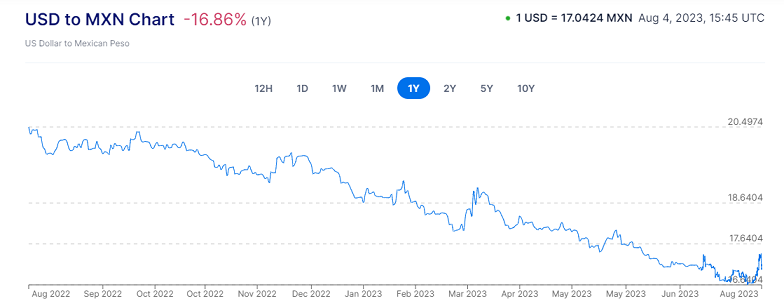Two hot questions making the rounds in online expat forums lately are some variation of the following … Why does the peso keep rising against the dollar? What’s the outlook for the U.S. dollar-peso exchange rate for the rest of the year?
So far in 2023, we’ve seen the peso’s value increase more than 12% versus the dollar, making life for those who earn USD and spend in pesos a lot more expensive. And though I’m no foreign exchange expert, as a former Wall Street analyst in the early 2000s and manager of my family’s investment portfolio, I do consume a LOT of financial news.
For those who don’t follow global economics, below is a quick summary of the primary reasons for the peso’s incredible appreciation lately:
1. Remittances from the U.S. to families here in Mexico are way up. Mexicans working in the U.S. generally send a lot of money to their relatives in Mexico. Lately, a hot U.S. economy has meant record money flows to Mexico in 2023, driving up demand for pesos as U.S. dollars get converted into pesos by the families that receive remittances.
2. Record high interest rates of 11.25% in Mexico. To combat soaring inflation, the Bank of Mexico (known as “Banxico”) aggressively raised rates over a 2-year cycle starting back in June 2021, from 4% in mid-2021 to more than 11% today. This nosebleed rate attracts investor capital from all over the world in search of high returns.
3. Strong foreign direct investment in Mexico. Following major disruption to their supply chains during the pandemic, global manufacturers have sought to reduce their reliance on Chinese factories and situate their suppliers closer to the U.S. market. This phenomenon known as “near-shoring” has also increased demand for pesos.
Where Does the Mexican Peso Go From Here?
The honest truth is that no one has a crystal ball, and predicting where the peso goes from here is tricky. That said, there’s reason to believe that one or more of these factors driving peso appreciation lately will start to ease.
One wild card is the U.S. economy. If there’s an economic slowdown up north later this year or in 2024 (likely in response to tighter monetary conditions by the U.S. Federal Reserve), those remittances from Mexicans living in the U.S. will slow down. A weaker U.S. economy would also likely hit the tourism sector, as Americans cut back on foreign travel.
Banxico also paused its interest rate hikes back in May. With Mexico’s official inflation rate at its lowest level in 2 years, the Bank has signaled it intends to hold rates at current levels for a while. This will also alleviate upward pressure on the peso.
The third factor – nearshoring by companies looking for a low cost alternative to manufacturing in China – is likely to continue, so demand for pesos will still remain robust in this area.
Smart money appears to be betting on a slight weakening of the Mexican peso in the months ahead. Analysts at Bloomberg, Citibanamex, and Goldman Sachs expect the peso to end the year around 18.3-18.5 to the dollar, which would be a welcome relief for many living here on fixed, dollar-based incomes.
How Mexico Is Harmed by a Strong Peso
There are also several downsides for Mexico from a persistently strong peso.
Mexican companies reliant on exports (oil, vehicles, food products) are feeling the pain, as their products become much more expensive overseas. Anecdotally, we know a handful of exporters here in Guadalajara — and they are quick to say that the ‘super peso’ is really hurting their businesses, and are hoping for some relief soon.
And for Mexican families who depend on remittances from the U.S. to live — they are seeing their purchasing power eroded – unless their relatives send even more dollars, to make up for the loss. (Sending $1,000 USD last year when the exchange rate was 20:1 bought 20,000 pesos. Sending the same amount today yields roughly 17,000 pesos.)
Additionally, foreign tourism in Mexico is likely to suffer under a ‘super peso.’ Potential visitors to Los Cabos, Puerto Vallarta, and other hotspots are starting to look less attractive compared to other countries where their dollars go a lot further. As someone who spent a lot of time in Airbnb’s in Jalisco a year ago, while perusing Mexican properties this summer, I can confirm that they’re offering a lot less value now.
Tourism is critical to the overall health of the Mexican economy, contributing 8.5% to GDP and employing more than 4 million people. Fewer foreign tourists in a sector still not fully recovered from the pandemic would be bad news for AMLO, who is motivated to keep the economy humming ahead of next year’s Presidential election that his Morena party is heavily favored to win.
Bottom line – it’s far from clear where the peso will end the year versus the U.S. dollar, but my bet is on it easing somewhat as domestic pressures stack up. I would not be surprised to see the peso end 2023 in the ballpark of 18 to the U.S. dollar, as many analysts are predicting.
How to Monitor Changes in the Peso vs. USD Exchange Rate
One easy thing you can do to maximize the pesos in your wallet is to sign up for daily email alerts from xe.com.
When I see the dollar has strengthened against the peso (like it did yesterday) I’ll head to the ATM to withdraw funds from my U.S. bank account. While this strategy probably won’t net a big bonus on any one transaction, over the course of a year it could put thousands of extra pesos in your pocket.
What do you think is next for the peso? Share your thoughts in the comment section below.
Sources: Reuters, The Wall Street Journal, El Pais

